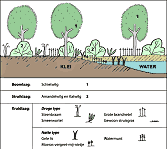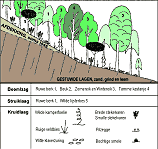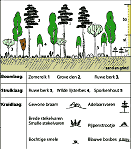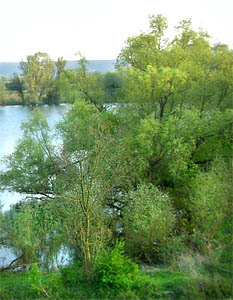In vegetation dominated by large plants it is often possible to distinguish several horizontal "layers". In most Dutch forests the following four layers can be encountered: a tree layer (bo), a layer of shrubs (st), a layer of herbaceous plants (kr) and a moss layer. Some examples of layering in the surrounding of Nijmegen are the Willow-flood-woods in the Groenlanden in the
Ooijpolder, the oak-beech-wood (slope woods) on the
glacial tills and the birch-oak-wood in
Heumensoord. Some woods have two tree layers with respectively species growing high and other that remain short or they have two layers of herbaceous plants with a similar spatial arrangement. Layering is most prominent in the tropical rain forest where often three (and more seldomly four or five) tree layers can be distinguished.
| Layering in the vegetation |
 |  |  |
| Willow-flood-woods in the Ooijpolder | Oak-beech-wood on the glacial tills | Birch-oak-wood in Heumersoord |
 Each layer corresponds to its own environmental factors, an own habitat and meso-climate, different from others. The crests of the trees, for example, are directly exposed to the wind and received the total sunlight, while the other, lower layers are more or less shielded with respect to those two abiotic factors. The shielding effect becomes more prominent towards the soil level, such that the plants in the lowest layer not only get the least sunlight, but that they are also surrounded by the most humid atmosphere and the most stable temperature.
Each layer corresponds to its own environmental factors, an own habitat and meso-climate, different from others. The crests of the trees, for example, are directly exposed to the wind and received the total sunlight, while the other, lower layers are more or less shielded with respect to those two abiotic factors. The shielding effect becomes more prominent towards the soil level, such that the plants in the lowest layer not only get the least sunlight, but that they are also surrounded by the most humid atmosphere and the most stable temperature.
The roots of plants from disitinc layers also populate different "places". Roots of trees partly utilize the upper soil levels but even more the deeper soil layers, whereas the roots of herbaceous plants occupy the same upper layer and the humus-rich top layer. Rhizoids of mosses rely on the presence of a humus-rich top layer. Roots of plants from various layers may thus depend on soillayers that differ strongly in availablity of air water and nutrients.
The phenomenon "Layering" is of course not restrained to forestrial vegetation. In the herbaceous plant community of a swamp or grassland for example, most ofthe time three layers can be distinguished: a layerof high dominating grasses and sedges, at least one intermediate layer with herbs, lower grasses and sedges and a lowest layer with mosses and liverworths.







